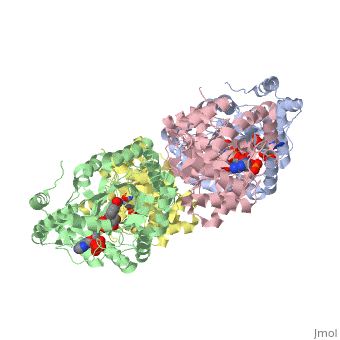Function
Ion channels are membrane proteins that catalyze the passive transport of ions through the cell membrane. Ion channels are the fastest of all membrane transporters, with 106 to 108 transported units per second versus 102 to 104 molecules per second for porters/carriers, or 100 to 103 for ATP-driven pumps.
Ion channel types
Most ion channels are specific to an ion, like the sodium channels, or the Potassium Channel[1].
- TRP channels let through various cations[2].
Another property of ion channels is that they can be either driven by voltage or by concentration gradients, or they can be gated (by voltage, ligands, touch and other sensory signal).
- Potassium channels (KCh) are subdivided to voltage-gated KCh and calcium-dependent KCh. The latter are subdivided into high- (BK, LKCa), intermediate- and small-conductance KCh (human SK1, rat SK2, SKCa). See: Potassium channels.
- MthK is a calcium-dependent potassium channel from Methanobacterium thermoautrophicum[3].
- MscL and MscS are large- and small-conductance mechanosensitive channels which protect bacteria from osmotic shock by allowing ions to flow across the cell membrane[4].
See:
Mechanosensitive channels: opening and closing.
- Voltage-Dependent Calcium Channels (VDCC) allow calcium ions to enter the cell resulting in muscle contraction, neuron excitation or hormone release. VDCC are composed of several subunits and are named as a Cav gene product[5].
See:
Voltage-gated calcium channels.
Voltage-gated calcium channel Cav1.1 complex.
There are also Voltage-Dependent Anion Channels (VDAC)[6].
- Chloride ion channels (ClCh) are involved in maintaining pH, volume homeostasis and more. The anti-parasitic drug Ivermectin binds to glutamate-gated chloride channels.
See:
Chloride Ion Channel
User:Laura Fountain/Chloride Ion Channel
Chloride Intracellular Channel Protein 2
- Calcium-activated chloride channel or anoctamin or scramblase or TMEM16 are important in cell volume regulation and malignancy[7].
- Bestrophin is another type of Calcium-activated chloride channel[8]
- Ligand-Gated Ion Channels (LGIC) open or close when binding a ligand like a neurotransmitter[9].
See Structural evidence for mono- and di-carboxylates binding at pharmacologically relevant extracellular sites of a pentameric ligand gated ion channel [10]
- Cyclic Nucleotide-Gated channels (CNGC) conduct cations upon binding of cAMP or cGMP[11].
- Acid-Sensitive channels (ASC) conduct cations upon binding of acid[12].
- Transient receptor potential cation channel (TRP) superfamily consists of 6 subfamilies: canonical, melastatin-related, ankyrin, mucolipin, mucolipidosis, polycystic and vanilloid (TRPV) which is heat-sensitive [13]. For details see Transient Receptor Potential Cation Channel Subfamily V Member 1 (TRPV1).
- Glycerol facilitator (GlpF) is a protein channel which transports glycerol across the cell membrane of E. coli[14].
Other ion channel proteins are the aquaporins, annexin V, gramicidin, antiamoebin, trichotoxin, peptaibol and the glutamate receptor. Specific details in:
Classification
TCDB, the most sophisticated classification of transport proteins to date, classify ion channels as a heterogenous subset of all α-type channels, whose singular property is to consist mainly of α-helices that span the membrane. They are distinct in this from the beta-barrel porins and the pore-forming toxins, as well as from non-ribosomally synthesized channels like gramicidin, polyglutamine or digitoxin. All these proteins are passive transport proteins.
Disease
Mutations in sodium channel are involved in arrhythmia[15], epilepsy[16], Brugada syndrome and cardiac conduction disease[17]. Many diseases are related to voltage-gated sodium, potassium, chloride, acetylcholine and glycine ion channels[18]. Mutations in several members of the calcium-activated chloride channels or anoctamin are liked to several diseases: ano-1 to cancer, ano-5 to muscular dystrophy, ano-10 to ataxia and ano-6 to Scott syndrome[19]
Mutations in bestrophin are associated with macular dystrophy[20].
Amiodarone and Amlodipine are voltage-gated calcium channel blockers used in treatment of cardiac dysrhythmias.
Additional Resources
For additional information, see: Membrane Channels & Pumps
For additional information, see: Hypertension & Congestive Heart Failure
3D structures of ion channels
Ion channels 3D structures

